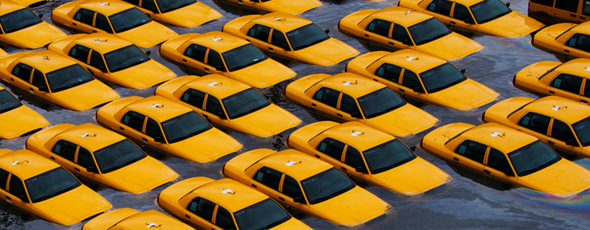
As I brought supplies to Hermana’s car from Occupy Sandy’s Free Store on Staten Island, she seemed abashed to ask for anything more. “What else can we get you?” I asked. “Do you need cleaning supplies? Food? Batteries? Take anything you need.” She smiled and mumbled amiably. I was immediately struck by her apparent shame, her reticence, and her confusion about Occupy Sandy’s approach, as if she expected some ulterior motive. After explaining that yes, everything is free and she really could take anything she needed, we were soon filling her car with supplies until we could barely close the doors.
Occupy Sandy was set up a few days after Hurricane Sandy hit the East Coast. The monetary damage has been catastrophic, numbering in the billions of dollars. The emotional damage is incalculable. Hermana’s house on Staten Island was left relatively unscathed after Hurricane Sandy, but her daughter’s house was severely damaged. Three weeks after the storm, many houses still had no power and large social housing projects were relying on gasoline generators that spewed harmful fumes into the air.
The Free Store and Community Centre Occupy Sandy set up in Staten Island’s Midland Beach neighborhood aims to provide some remedies. It serves many purposes. Whether it’s providing food, supplies, or a friendly person to talk to, people undoubtedly come to the Free Store to regain some traction in their lives.
Occupy Sandy operates on the same guidelines as Occupy Wall Street: non-hierarchical, horizontal organising structures and an acute awareness of privilege and inequality. Volunteers get involved by approaching one of the many ‘hubs’, which act as driver and volunteer dispatch centres as well as collection centres. People from across the country have donated goods (via a ‘gift registry’ scheme); at times vast stocks of supplies have overwhelmed the volunteers and the space in the hubs.
Immediately upon entering the hub at 520 Clinton Avenue in Brooklyn, one is greeted by a banner reading “Mutual Aid, Not Charity.” Mutual Aid is a term the left employs to make a distinction from the oft-discouraged ‘liberal charity’, even when the differences appear blurred.
The term “mutual aid” is sometimes used as if it’s something that one can turn on and off, something that can be practised one day and discarded the next. Many thus say they are “going to practice mutual aid”. Where Occupy Sandy differs from charitable organisations is in its pledge to use community centres as long-term organising hubs (what to organise around remains up in the air) that are imbued with an ethos of mutual aid and that empower residents to gain control of their communities.
The beauty of Occupy Sandy, like OWS, is that it channels people’s efforts and talents in constructive ways. Workshops, skill-shares, and all kinds of other teachings happen daily. They range from sensitivity training – being aware of the devastated communities you are entering – to anti-oppression training. Carpenters, construction workers and social workers have all been able to volunteer through Occupy Sandy. Meanwhile, people who do not consider themselves activists are learning about radical approaches to basic human interaction, which is crucial to both understanding and undermining an essential component of neoliberalism: atomisation.
Hermana’s caution underscored the importance of transforming social relationships under neoliberalism. Alienation from our neighbors is perhaps neoliberalism’s lifeline, its insurance policy that reproduces a dormant, apolitical population. People feel disconnected from others and rely on themselves, even going so far as to deprive themselves of needs that others could fulfil. Occupy Sandy’s practice of mutual aid and building community seeks to erase the assumption that human relations exist upon predation and exploitation. Instead, it formalises and sustains relations that run counter to the very existence of predatory capitalism.
A leaflet published by the New York City anarchist group In Our Hearts states that mutual aid is “not about assuaging guilt.” Rather, it’s about addressing privilege while threatening the status quo. It is about “sharing amongst equals in different positions of need” rather than sharing with those “beneath you”. Most importantly, it is a social relationship. On the other hand, charity, as the Liverpool Solidarity Federation writes, is “a veil for predatory capitalism to hide behind as it attacks the working class.” The Salvation Army, The Federal Emergency Management Agency (FEMA), and the American Red Cross are, and have always been, knee-jerk reactions to storm devastation. They do nothing to address the class relations that pre-empted the scope of this crisis. Where Occupy Sandy succeeds, and must continue to succeed, is in its ability to bridge the effects of neoliberal capitalism and Sandy’s destruction.
Occupy Sandy must form more coherent and accessible critiques of capitalism than its predecessor, focusing less on ameliorative solutions than on transformational ones. It must not only provide supplies and social services, but also explain Sandy’s exacerbation of social ills, radically changing the foundations of social relationships in the process.
By Ryan Hickey (@Rizak11)









